- Approximately 70,000 miles of rivers cover Georgia’s landscape.
- Some of the most common snakes in Georgia’s rivers include the banded water snake and the queen snake.
Snake-Infested Georgia Rivers: What You Should Know
Georgia is known for its beautiful landscapes and friendly locals, putting you in the middle of one of the most abundant river systems in the country. These rivers give the region a welcoming appearance, but what’s inside is much different. Among the 70,000+ miles that decorate Georgia with different rivers and streams, seven are the most snake-infested rivers in Georgia.

Georgia has one of the biggest rivers in the country, giving it the greatest volume of snakes in the state.
©Nolichuckyjake/Shutterstock.com
The entirety of the rivers in Georgia are broken down into 14 major basins before being broken down further into 52 watersheds. Many authorities, including the Georgia River Network and the Georgia Water Coalition, work to preserve these natural ecosystems. Georgia’s snake-infested rivers are the home to many different species, but the most common sightings include:
- Banded water snake
- Sometimes breed with midland water snakes.
- Found in swamps, rivers, and lakes all over the state.
- Is non-venomous.
- Common water snake
- Prefers slow-moving water like slow streams, rivers, and still ponds in northern Georgia.
- Is non-venomous.
- Plain-bellied or red-bellied water snake
- Prefers rivers, lakes, ponds, and wetlands throughout the state except Okefenokee Swamp.
- Spends more time on land than over water snakes due to local humidity.
- Is non-venomous but has sharp teeth to bite in defense.
- Queen snake
- Prefers moving water like rivers and streams near Georgia’s mountains.
- Rarely seen far from water because of their skin’s permeability.
- Is non-venomous and timid around humans.
- Northern cottonmouth
- Also called water moccasins, black moccasins, or gapers.
- Prefers slow streams and rivers, marshes, ponds, and swamps in northern Georgia.
- Is venomous and found throughout the entire southeast United States.
- Green water snakes
- Typically found in southern Georgia.
- Prefer bodies of water with lots of vegetation, including swamps.
- Non-venomous, but swallows prey whole, rather than constricting them.
Still, this is only a fraction of the water snakes that make their habitat in Georgia’s rivers.
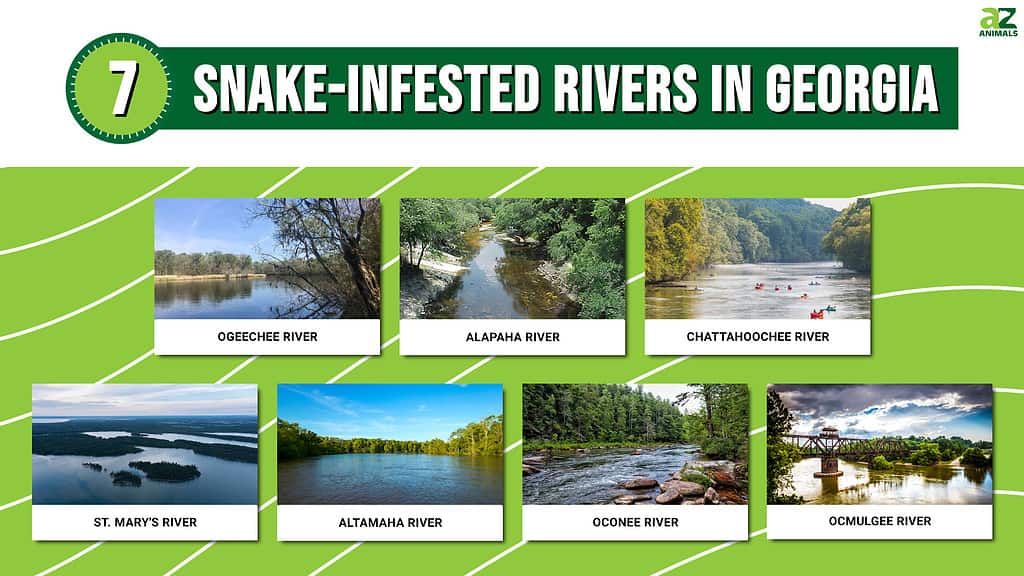
5 Most Snake-Infested Rivers in Georgia
While rivers decorate most of Georgia, the biggest saturation of rivers is in the southern area. That’s why the Ogeechee River and Alapaha River have so many snake sightings. Here are 5 of the most snake-infested rivers in Georgia.
1. Ogeechee River – Piedmont Province
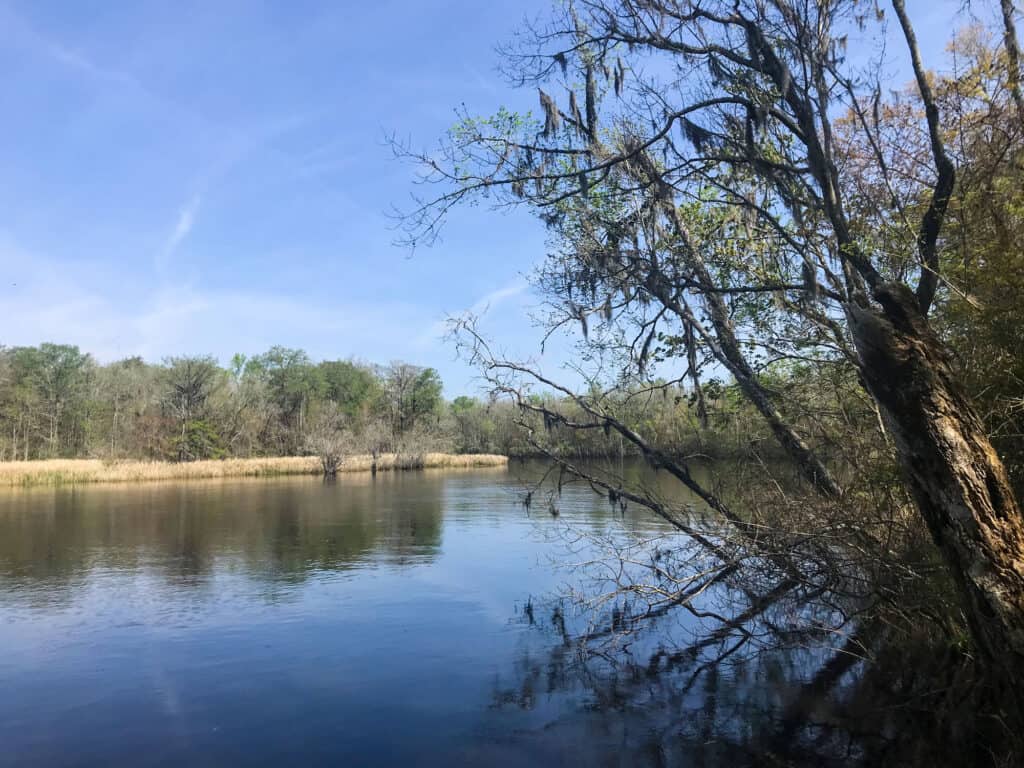
The snake-infested waters of the Ogeechee River welcome a variety of wildlife, including the water moccasin.
©iStock.com/Yvonne Wilemon
Ogeechee River is part of a greater basin, which contains itself wholly within Georgia’s borders. The creation of several nearby islands (including the Blackbeard and Sapelo islands) relied on the drainage that comes from this river. As one of the biggest freshwater resources in Georgia, the Ogeechee River Basin provides water for 394,000+ people.
If you want to see these snake-infested waters for yourself, walk through the nearby Fort McAllister State Historical Park, which has oak trees and salt marsh. The most common snake is the brown water snake, which Georgia currently protects.
2. Alapaha River – Berrien County
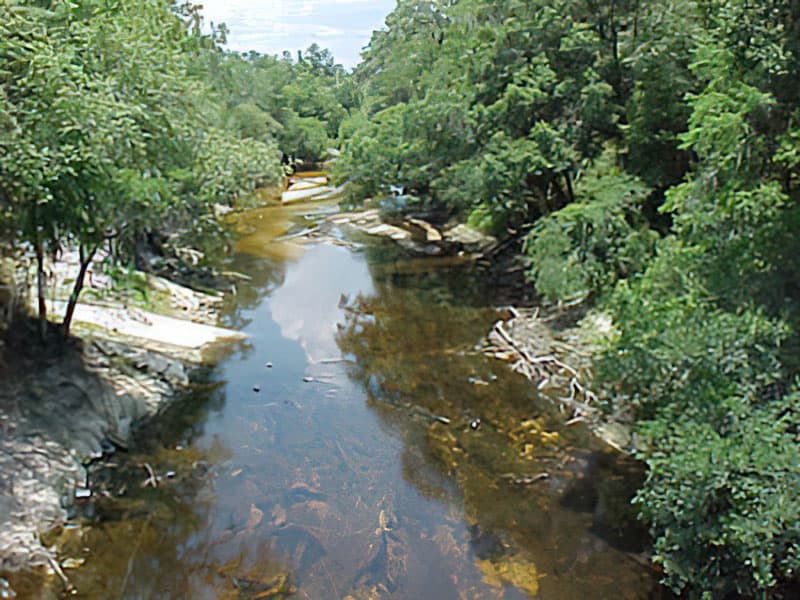
The Alapaha River is still a rich home for rivers due to its previous function as a snake sanctuary for Georgia’s water snakes.
©public domain – License
If there’s one river that you find infested with snakes, it is the Alapaha River. This river was once the Snake Sanctuary, though it also commanded attention as the Lentile Tract and the study site for indigo snakes. In September 2016, Alapaha River Wildlife Management opened 6,869 acres to the public.
Found between Irwin County and Tift County, the river acts as a connection point for many lakes within the nearby forests rather than providing a constant water flow. Researchers discovered that this river is home to many common and rare snake species, including eastern indigo snakes, Florida pine snakes, and others.
3. Chattahoochee River – Union County
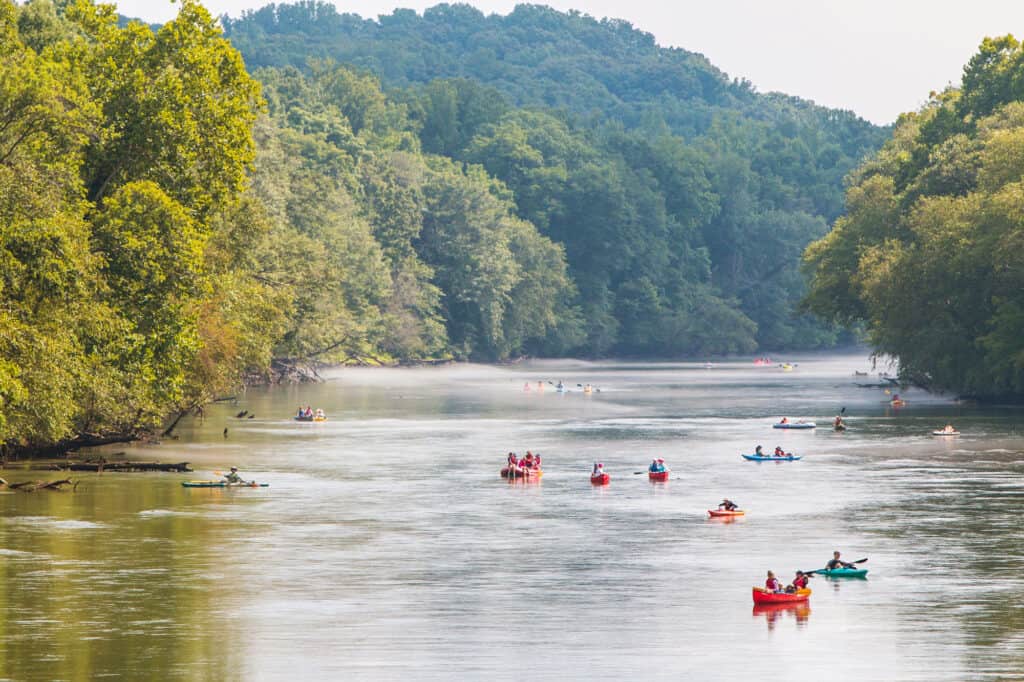
While the Chattahoochee River offers plenty of recreational activities, keep an eye out for the brown and Mississippi green water snakes.
©iStock.com/BluIz60
The Chattahoochee River weaves across 430 miles of the border separating Alabama and Georgia. It gets its name from the city it ends in, buried beautifully in Chattahoochee National Forest. Among the snakes of the Chattahoochee National Forest and River are the northern and southern water snakes, the southern copperhead, the brown water snake, and the Mississippi green water snake.
While coming across a snake within this river is common, only three of the main species near the Chattahoochee River are venomous. In the United States, dying of a snake bite is uncommon. However, Saugahatchee Creek – one of Chattahoochee River’s tributaries – is where a man met his end in 2004 for exactly this reason. The snake in question was a copperhead snake, which is one of the most common species in this area.
4. St. Mary’s River – Camden County
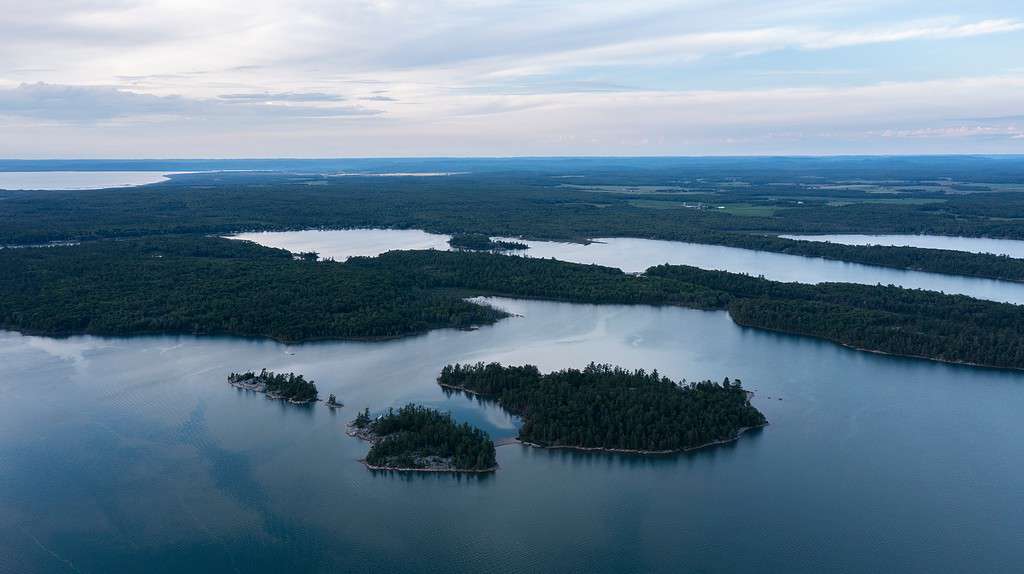
St. Mary’s River is an eclectic home for snakes, offering many different sources of nutrients and a lush landscape.
©Cory Woodruff/Shutterstock.com
This river flows along several states, touching a section of the shared border between Georgia and Florida. It is 126 miles long, originally known as “Phlaphlagaphgaw” to Native Americans in the area, which means “rotten fish.” It stretches from the Okefenokee Swamp to the Atlantic Ocean, and it was the location of the Battle of Fort Point Peter in the War of 1812.
Snakes are essential to the ecosystem within St. Mary’s River, though they are strikingly different from one another. The semiaquatic ribbon snake commonly swims along the river’s shoreline, paired with other local wildlife like beavers, otters, and turkeys.
5. Altamaha River – Montgomery, Jeff Davis, and Wheeler Counties
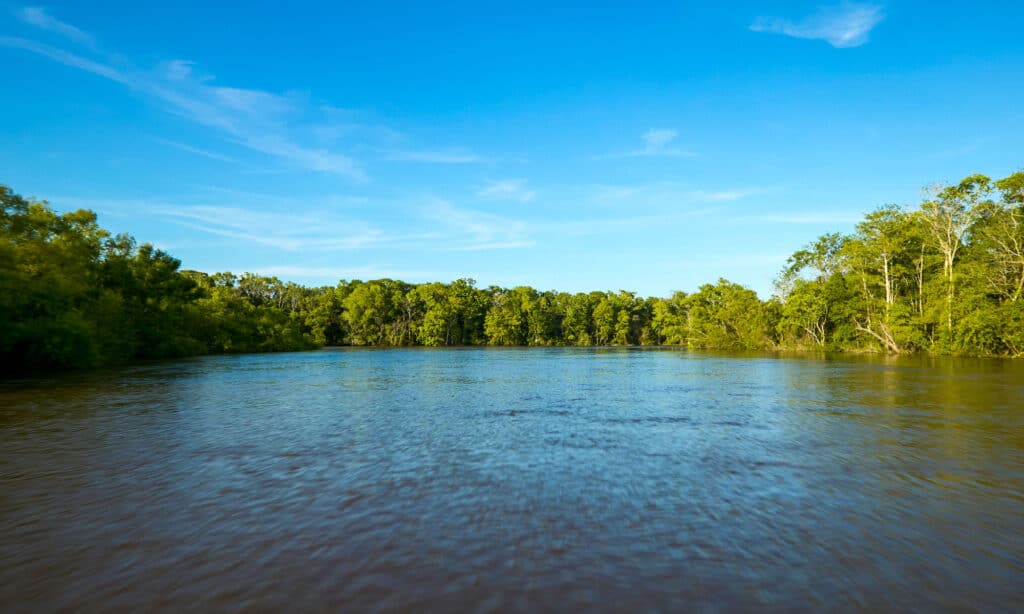
Over 280,000 people get their freshwater from the Altamaha River, despite being a home for many local water snakes.
©iStock.com/Colby Lysne
The Altamaha River is one of the largest freshwater sources of the Atlantic Ocean in the Western Hemisphere. Spanning 470 miles, it is one of the few rivers of this size to be contained within a single state. In total, this region contains dozens of different species of snake mixed with salamanders, lizards, and the American alligator. Conservation efforts by the Georgia Department of Natural Resources ensure the preservation of the complex habitats along the river.
The most common snakes of this river include the indigo snake, rainbow snake, and harlequin coral snake. The legend of the Georgia Sea Serpent is one of the local tourist attractions in the area for anyone who believes the legend.
6. Oconee River – Hall County

Oconee River is one of the best spots for fishing in Georgia, but keep an eye out for water snakes – they bite if you get too close.
©Tara Ballard/Shutterstock.com
The Oconee River steps from Lake Oconee, and the Oconee River Basin allows for drainage of 5,330 square miles. Like the Ogeechee River, the freshwater source offers drinking water to hundreds of thousands of locals in Georgia. Originally, the river got its name from a Muskogean people in Georgia, spelling the name many ways like Onoy, Ekwoni, Oconi, and Ocone. Oconee River is an excellent fishing spot for locals and tourists, with access to a nearby park and boat ramp.
The most common snakes in the Oconee River are banded and northern water snakes. While these water snakes aren’t venomous, they are aggressive towards humans if you try to touch them. Leave these snakes alone to avoid a painful bite.
7. Ocmulgee River – Newton County
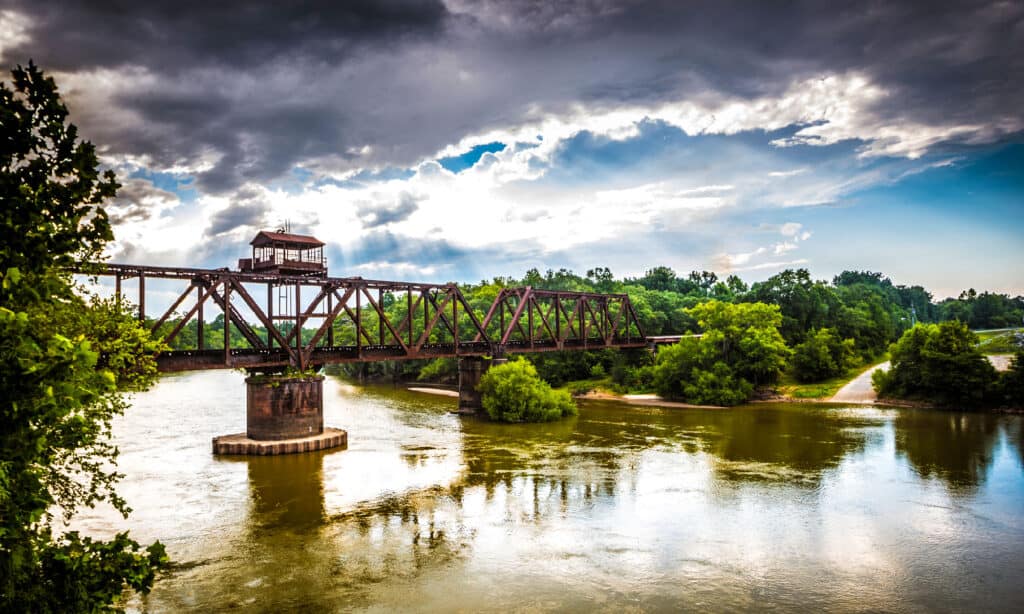
The water snakes of the Ocmulgee River come from the connection it shares with the Oconee River and the Altamaha River.
©iStock.com/annbertschin
The Ocmulgee River is part of the Ocmulgee River Basin that drains 6,180 square miles. Once it connects with the Oconee River, it eventually forms the Altamaha River. The river is 255 miles long, providing a gentle flow for wildlife that prefers a calmer environment.
When you take a hike along the trails in the nearby national park, keep an eye out for copperheads and water moccasins. They are particularly abundant around the Ocmulgee Mounds, though the southern, northern, and brown water snakes span the entire river.
Summary of the Most Snake-Infested Rivers in Georgia
| 1 | Ogeechee River | Piedmont Province |
| 2 | Alapaha River | Berrien County |
| 3 | Chattahoochee River | Union County |
| 4 | St. Mary’s River | Camden County |
| 5 | Altamaha River | Montgomery, Jeff Davis, and Wheeler Counties |
| 6 | Oconee River | Hall County |
| 7 | Ocmulgee River | Newton County |
The photo featured at the top of this post is © iStock.com/David_Camarillo
Thank you for reading! Have some feedback for us? Contact the AZ Animals editorial team.






